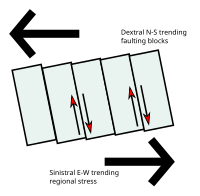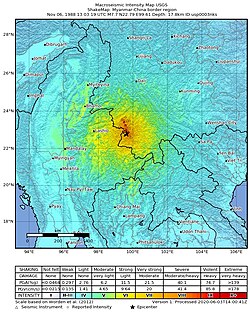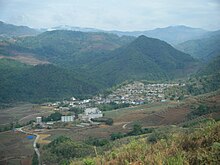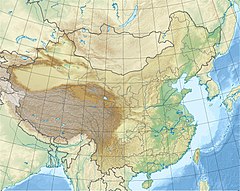1988 Lancang–Gengma earthquakes
| UTC time | 1988-11-06 13:03:19 |
|---|---|
| 1988-11-06 13:15:43 | |
| ISC event | 419867 |
| 419869 | |
| USGS-ANSS | ComCat |
| ComCat | |
| Local date | 6 November 1988 |
| Local time | 21:03 |
| 21:15 | |
| Magnitude | Mw 7.0 |
| Mw 6.9 | |
| Depth | 18 km (11 mi) |
| 15 km (9.3 mi) | |
| Epicenter | China–Myanmar border region 22°47′20″N 99°36′40″E / 22.789°N 99.611°E |
| Type | Strike-slip |
| Areas affected | China, Burma and Thailand |
| Total damage | US$270 million in 1988 |
| Max. intensity | CSIS IX (1st shock) CSIS X (2nd shock) |
| Landslides | Yes |
| Foreshocks | Yes |
| Aftershocks | 600+ |
| Casualties | 748–939 fatalities, 7,700+ injured |
On 6 November 1988, two earthquakes struck Lancang and Gengma counties, Yunnan, near the China–Myanmar border. These earthquakes measured moment magnitude (Mw ) 7.0 and 6.9, respectively, spaced 12 minutes apart.[1] These earthquakes were assigned a maximum China seismic intensity of IX and X, respectively. Between 748 and 939 people were killed; more than 7,700 were injured. Both earthquakes caused damage and economic losses estimated at CN¥ 2.05 billion (CN¥8 billion in 2023). Moderately large aftershocks continued to rock the region, causing additional casualties and damage.
Tectonic setting
[edit]
The Shan Plateau is crisscrossed by strike-slip faults to accommodate crustal rotation of the Sunda Block and deformation as a result of the India–Asia collision, where the Indian plate is underthrusted beneath the Eurasian plate. The Shan Plateau formed by uplift along the Shan Scarp Fault Zone, an inactive shear zone and thrust fault along its western base.[2][3] Located east of the Shan Scarp Fault is the active Sagaing Fault, a dextral transform fault that separates the Burma plate from the Sunda plate. At the northern boundary of the Shan Plateau lies the Red River Fault, an active 1,000 kilometres (620 mi) long dextral fault.[4]
Earthquakes in this part of Southeast Asia (the Shan Plateau) usually display focal mechanisms corresponding to shallow left-lateral (sinistral) and right-lateral (dextral) strike-slip faulting.[5][6] Shear deformation between the Red River and Sagaing faults causes bookshelf-style faulting which manifests in predominantly dextral faulting within the Shan Plateau.[7] Sinistral systems follow an east–northeast or east–west trend for several hundred kilometers, offsetting the Mekong and Salween rivers. Dextral structures follow a north-west or north-southernly strike. The earthquakes of 1988 were the result of slip along a dextral fault zone.[6]
In 1995, another earthquake measuring 6.8 Mw struck the same area.[8] It left at least 11 people dead, destroyed over 100,000 homes, and damaged an additional 42,000.[9] The earthquake may have been triggered by the transfer of stress from the 1988 events.[7]
Earthquakes
[edit]These earthquakes originated along the Longlin–Lancang Fault Zone; a northwest–southeast striking, 210 kilometres (130 mi)-long structure. Its northern section is a single strand while the southern section comprises a complex anastomosis of faults. Forming in the early to mid-Miocene, this dextral fault has accumulated 17 kilometres (11 mi) of displacement. Its estimated slip rate is 3.4 mm (0.13 in) per year.[10] It was previously a sinistral fault as 30 km (19 mi) of left-lateral offset was observed in a batholith from geological studies.[11]
The first mainshock measured Mw 7.0 to 7.7.[12] It generated a surface ruptures with right-lateral offsets of 1.4–2 metres (4 ft 7 in – 6 ft 7 in) and a small reverse component.[10] The maximum measured dextral surface offset was 2.0 metres (6 ft 7 in) and vertical offset was 0.5 metres (1 ft 8 in).[11][13] These ruptures followed a north–northwest strike for about 24 kilometres (15 mi). It ruptured an estimated 53 kilometres (33 mi)–70 kilometres (43 mi)-long by 26 kilometres (16 mi)-km-wide fault zone extending northwest–southeast.[10] The rupture propagated with a velocity of 2 km (1.2 mi) per second.[10]
A Mw 6.9 shock struck 63 kilometres (39 mi) north–northwest of the first some 12 minutes later.[14] The rupture area was nearly twice that of the first event.[15][10] They are largest earthquakes to affect both the Chinese–Myanmar border region since 1970 (Ms 7.7) and 1912 (Mw 7.8), respectively.[16]
Aftershocks
[edit]By 20 December, the Kunming Telemetered Seismic Network had recorded over 600 aftershocks greater than Ms 3.0. Three of the largest had Ms of 6.1, 6.3 and 6.7 on 15, 27 and 30 November, respectively. The aftershocks were distributed in a pattern consistent with a north–northwest trending fault responsible for the mainshocks.[14] These aftershocks caused additional damage and injuries.[17][18] On 7 May 1989, a Mw 5.6 aftershock killed one and left 91 others injured. It also caused damage totaling US$54 million and affected 5,300 homes in Gengma County.[19]
Intensity
[edit]
The first shock was assigned a maximum intensity of IX on the China seismic intensity scale.[20][21] This zone had an axis length of 27 kilometres (17 mi), with its widest width at 8 kilometres (5.0 mi), covering a 170 km2 (66 sq mi) area. It extended northwest–southeast from Mujia to Zhutang Township. The northeast border lie along the eastern bank of the Heihe River, west of Fubang Township. Landslides, surface ruptures, liquefaction and ground failure were observed.[15]
Intensity VIII encompassed Xuelin Wa Ethnic Township in Mujia Township to the north, and Zhutang Township to the southeast. Within this zone was Ximeng County to the west. This zone had an axis length of 52 kilometres (32 mi) and a width of 20 kilometres (12 mi), covering an area of 820 km2 (320 sq mi). Nearly every house in the region collapsed, with very few left intact. The earthquake also caused landslides and ground failures throughout.[15]
Cangyuan County in the north to Shangyun, and Lancang County in the south were within the area of VII. The western boundary also extended into Ximeng County, well beyond the Myanmar–China border, into Shan State. Damage was less extreme although some houses collapsed. Light homes remained intact, and much of the damage to ordinary homes reported include cracking of walls. Landslides, ground cracks and sand boils occurred. This zone covered a large area of 3,680 km2 (1,420 sq mi).[15] The evaluated Mercalli intensity in Chiang Mai was VI (Strong) based on some damaged buildings.[22]
The second mainshock had a maximum intensity of X.[21][15] The zone included Gengma County to the north, and Yanshuai towards the south, Tuanjie Township, Cangyuan County to the east, and Mengsheng Township, Cangyuan County in the west. Many houses totally collapsed or were severely compromised in this zone. Many buildings were also seriously damaged. Lightly constructed homes collapsed or tilted due to damage resulting from the rupture. Liquefaction and fissures ejecting water were observed. This zone is a north-west ellipse with a major axis of 25 kilometres (16 mi) and a minor axis of 8 kilometres (5.0 mi), covering an area of 160 km2 (62 sq mi).[15] The intensity VIII zone extended from Gengma in the north to Yanshuai and Nuoliang Township in the south. Few homes remained standing and lightweight houses tilted. Damage to the ground was identical to those observed in the zone of IX. This zone followed a north-west ellipse area of 940 km2 (360 sq mi).[15]
Aiguo New Village, Gengxuan Town, Gengma County in the north, to south of the Shuangjiang River in the east, to south of Lancang Shangyun in the south, and west to Minliang of Menglai Township, Cangyuan County in the west were within the intensity VII zone. Adobe houses totally collapsed as a result. Intensity VII was felt for an area of 3,020 km2 (1,170 sq mi). Intensity VI from the second shock covered an area of 32,700 km2 (12,600 sq mi).[15]
Damage and casualties
[edit]
Early figures of fatalities were 18 and 37, which could not be revised due to the communication disruptions. Over the next few days, international media reported at least 600 inhabitants killed, mainly in the village of Shanmato which was obliterated. Telecommunication services were cut and severely disrupted. This meant provincial government officials could not provide updated figures on the dead.[23]
On 9 November, the death toll totaled 938.[24] Chinese officials stated 748 people died; at least 7,700 people seriously injured; over 3 million affected and 267,000 homeless.[15] They added that the death toll could have been higher had the earthquakes struck near a city. When the earthquakes struck, many residents were outdoors, which factored in the unexpectedly low death toll. A fatality figure of 938 was given to the United Nations and became widely reported.[25] The reported death toll by the International Disasters Data Base was 939.[26] It was regarded as China's "worst earthquake in more than a decade".[27] At the time of the earthquakes, the population of Lancang and Gengma counties were 237,000 and 81,000, respectively.[28] In Lancang County, at least 607 people died including 279 in Zhanmapo.[29]
Seventeen counties were heavily damaged. Many homes, roads and communication lines in Lancang and Mengliang counties were destroyed.[30] An estimated 200,000 buildings including 144,000 houses were razed. Over 1.308 million rooms collapsed and 934,800 were damaged.[31] At least 500,000 buildings including 253,000 homes were badly damaged.[30] More than 4,000 essential facilities in Yunnan were damaged. About 1,000 schools, 98 clinics and 29 reservoirs were destroyed. Landslides in the area also damaged highways. The majority of homes constructed of wood and mud, collapsed due to the extreme ground motions, killing its inhabitants.[23] Over 1,000,000 m3 (35,000,000 cu ft) of rockslides damaged highways and blocked rivers, halting water transportation. Kunming, the capital of Yunnan Province, was undamaged, although the earthquakes were felt strongly. The total cost of damage was estimated at CN¥ 2.05 billion (CN¥8 billion in 2023).[15]
Many buildings generally fared well during the earthquakes because of improved construction practices and seismic retrofitting works prior. Buildings which had survived were built with the consideration of the local seismic hazard. Some buildings including a cinema which was designed to withstand seismic intensity VIII and a residential block made to resist intensity IX were undamaged. These buildings were strengthened before the earthquakes.[31] In Thailand, additional damage occurred in Chiang Rai and shaking was felt on skyscrapers in Bangkok.[32][22] Strong to weak shaking was felt in Thailand, Laos, Vietnam and Bangladesh. In Bangkok, Thailand, people on high-rise buildings felt weak shaking. The highest floors of the Charn Issara Tower, a 27-story building, swayed for a few minutes.[32]
Response
[edit]
Due to its remote location and the lack of communication and damaged roads, rescue and aid transportation efforts faced difficulties getting to the affected areas.[33] Rescuers and medical personnel only reached the affected zone on 9 November.[34] The Yunnan government ordered an airlift of medical and relief supplies to help those affected. The governor of Yunnan Province, He Zhiqiang, along with several medical doctors were brought to the disaster scene.[23] Several thousand troops and many military vehicles also visited the affected areas, according to the Ministry of Civil Affairs.[35]
Much information about the earthquakes and its devastation were hidden by the Chinese government due to ongoing political and cultural reforms at the time.[36] In the early decades of China's communist regime, the guideline was that natural disasters and accidents would not be disclosed unless foreign nationals were involved.[25] It was only in the few years prior to 1988 were these events publicized. At a press conference following the earthquakes, officials disclosed that a magnitude 7.7 event in 1970 resulted in 10,000 deaths.[25] Chinese officials called for international assistance in response to possible aftershocks. The World Food Programme and United Nations Development Programme said the nation encouraged international groups and governments to provide aid, and that plastic sheets for shelter, medicine and food were the most important items.[37]
See also
[edit]- 1976 Longling earthquake
- List of earthquakes in 1988
- List of earthquakes in China
- List of earthquakes in Myanmar
- List of earthquakes in Yunnan
- List of earthquakes in Thailand
References
[edit]- ^ a b ISC (27 June 2022), ISC-GEM Global Instrumental Earthquake Catalogue (1900–2009), Version 9.1, International Seismological Centre
- ^ Soe Min. "Fault segmentation and active tectonic criteria of the Shan Scarp Fault Zone, Shan Plateau Region, Myanmar". Mnces 2019.
- ^ Socquet, Anne; Pubellier, Manuel (29 March 2004). "Cenozoic deformation in western Yunnan (China–Myanmar border)" (PDF). Journal of Asian Earth Sciences. 24 (4): 495–515. doi:10.1016/j.jseaes.2004.03.006.
- ^ Li, Yujiang; Shao, Zhigang; Shi, Fuqiang; Chen, Lianwang (2020). "Stress evolution on active faults in the southwestern Yunnan region, southeastern Tibetan Plateau, and implications for seismic hazard". Journal of Asian Earth Sciences. 200: 104470. Bibcode:2020JAESc.20004470L. doi:10.1016/j.jseaes.2020.104470. S2CID 224901911.
- ^ Shi, X.; Wang, Y.; Sieh, K.; Weldon, R.; Feng, L.; Chan, C. H.; Liu-Zeng, J. (2018). "Fault Slip and GPS Velocities Across the Shan Plateau Define a Curved Southwestward Crustal Motion Around the Eastern Himalayan Syntaxis". Journal of Geophysical Research: Solid Earth. 123 (3): 2502–2518. Bibcode:2018JGRB..123.2502S. doi:10.1002/2017JB015206. hdl:10220/45249.
- ^ a b Wang, Yu; Sieh, Kerry; Thura Tun, Soe; Lai, Kuang-Yin; Myint, Than (2014). "Active tectonics and earthquake potential of the Myanmar region" (PDF). Journal of Geophysical Research: Solid Earth. 119 (4): 3767–3822. Bibcode:2014JGRB..119.3767W. doi:10.1002/2013JB010762.
- ^ a b Ji, Lingyun; Wang, Qingliang; Xu, Jing; Ji, Cunwei (2017). "The July 11, 1995 Myanmar–China earthquake: A representative event in the bookshelf faulting system of southeastern Asia observed from JERS-1 SAR images". International Journal of Applied Earth Observation and Geoinformation. 55: 43–51. Bibcode:2017IJAEO..55...43J. doi:10.1016/j.jag.2016.10.006. ISSN 0303-2434.
- ^ "M 6.8 – Myanmar". USGS-ANSS. Archived from the original on 31 October 2020.
- ^ National Geophysical Data Center / World Data Service (NGDC/WDS) (1972), Significant Earthquake Database (Data Set), National Geophysical Data Center, NOAA, doi:10.7289/V5TD9V7K
- ^ a b c d e Mozaffari, Parviz; Wu, Zhong-Liang; Chen, Yun-Tai (1988). "Rupture process of November 6, 1988, Lancang-Gengma, Yunnan, China, earthquake ofM s=7.6 using empirical Green's function deconvolution method". Acta Seismologica Sinica. 11 (1): 1–12. Bibcode:1998AcSSn..11....1M. doi:10.1007/BF02650450. S2CID 129586363.
- ^ a b Yu Wang. "Earthquake Geology of Myanmar" (PDF). Dissertation – via Caltech.
- ^ National Earthquake Information Center. "M 7.7 – Myanmar-China border region". United States Geological Survey. Archived from the original on 6 November 2019. Retrieved 23 February 2021.
- ^ Shunmin, Guo; Hongfa, Xiang; Ruiqi, Zhou; Xiwei, Xu; Xingquan, Dong; Wanxia, Zhang (2000). "Longling-Lancang fault zone in southwest Yunnan, China – A newly-generated rupture zone in Continental crust". Chinese Science Bulletin. 45: 376–379. doi:10.1007/BF02909774. S2CID 130422667.
- ^ a b Chen, Yuntai; Wu, Francis T. (1989). "Lancang—Gengma Earthquake: A Preliminary Report on the November 6, 1988, Event and its Aftershocks". Eos, Transactions American Geophysical Union. 70 (49): 1527. Bibcode:1989EOSTr..70.1527C. doi:10.1029/89EO00376.
- ^ a b c d e f g h i j Yang, Jideng; Wang, Shiqin. "1988年11月6日云南省澜沧-耿马7.6、7.2级地震". National Seismology Data Center. Yunnan Seismological Bureau. Archived from the original on 11 July 2021. Retrieved 22 February 2021.
- ^ Ornthammarath, Teraphan (2019). "Seismic damage to ancient monuments in Chiang Saen (Northern Thailand): implication for historical earthquakes in Golden Triangle area". Philosophical Transactions of the Royal Society A: Mathematical, Physical and Engineering Sciences. 377 (2155). Bibcode:2019RSPTA.37780255O. doi:10.1098/rsta.2018.0255. PMC 6710469. PMID 31424339.
- ^ National Earthquake Information Center. "M 5.5 – Myanmar-China border region". United States Geological Survey. Retrieved 23 February 2021.
- ^ National Earthquake Information Center. "M 6.1 – Myanmar-China border region". United States Geological Survey. Retrieved 22 February 2021.
- ^ National Earthquake Information Center. "M 5.6 – Myanmar-China border region". United States Geological Survey. Retrieved 23 February 2021.
- ^ National Geophysical Data Center / World Data Service (NGDC/WDS) (1972), Significant Earthquake Database (Data Set), National Geophysical Data Center, NOAA, doi:10.7289/V5TD9V7K
- ^ a b Wang, Hui; Qiang, Zuji; Yuan, Zhuzhong; Wang, Yanglong; Zhang, Hua; Zhao, Xiang; Gu, Yishan (1992). "Distribution of seismic intensities of the November 6, 1988, Lancang-Gengma earthquakes and their surface ruptures in Yunnan Province, China". Acta Seismologica Sinica. 5 (2): 343–354. Bibcode:1992AcSSn...5..343W. doi:10.1007/BF02651701. S2CID 129529222.
- ^ a b Lukkunaprasit, Panitan (1989). State of seismic risk mitigation in Thailand (PDF). Thailand: Chulalongkorn University. Archived from the original (PDF) on 4 March 2022.
- ^ a b c "Chinese quake registers 7.6, death toll hits 600" (PDF). The Observer. Associated Press. 8 November 1988. Archived (PDF) from the original on 23 November 2021. Retrieved 22 January 2021.
- ^ Kristof, Nicholas D. (9 November 1988). "Toll Reported in China Earthquake Reaches 938". The New York Times.
- ^ a b c Kristof, Nicholas D. (19 November 1988). "Chinese Disclose That Quake In 1970 Killed About 10,000". The New York Times. Archived from the original on 27 July 2018. Retrieved 23 July 2022.
- ^ Ramirez, Marizen; Peek-Asa, Corinne (2005). "Epidemiology of Traumatic Injuries from Earthquakes". Epidemiologic Reviews. 21 (1): 47–55. doi:10.1093/epirev/mxi005. PMID 15958426.
- ^ "Chinese earthquake worst there in decade". Desert Sun. 9 November 1988. pp. A2. Retrieved 16 May 2023.
- ^ "China says toll from quake hits 938, will increase". Desert Sun. New York Times. 9 November 1988. Retrieved 15 May 2023.
- ^ Kristof, Nicholas D. (10 November 1988). "China now says earthquake left 100,000 homeless". New York Times. Retrieved 15 May 2023.
- ^ a b UN Department of Humanitarian Affairs (8 November 1988). "China – Earthquake Nov 1988 UNDRO Information Reports 1–7". ReliefWeb.
- ^ a b Hu, Qingchang; Chung, Yicun (1989). "Yunnan November 6, 1988; M7.6, 7.2 Earthquakes". Earthquake Engineering Research Institute. Archived from the original on 1 August 2013. Retrieved 19 May 2021.
- ^ a b "Quakes hit China and Thailand". The New Paper. 7 November 1988. p. 11. Retrieved 27 June 2024.
- ^ "铭记"11.6"(二)". Sohu. Sohu. 8 November 2018. Retrieved 28 February 2021.
- ^ "Teams reach quake area". Vol. 132, no. 19. Press Democrat. 9 November 1988. p. 8. Retrieved 15 May 2023.
- ^ Tyson, James L. (9 November 1988). "Peking sends help to Yunnan, 'China's earthquake center'". The Christian Science Monitor. Retrieved 22 January 2021.
- ^ "Hundreds injured in China earthquake". The Guardian. Associated Press. 10 July 2010. Retrieved 22 January 2021.
- ^ "China wants aid as more tremors expected". The Straits Times. Agence France-Presse. 10 November 1988. p. 3. Retrieved 27 June 2024.
External links
[edit]- Aftershocks M4.0 or greater from 1988 to 2000 (USGS)
- The International Seismological Centre has a bibliography and/or authoritative data for this event. (First event)
- The International Seismological Centre has a bibliography and/or authoritative data for this event. (Second event)



